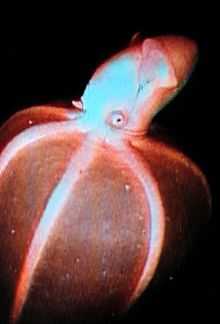Stauroteuthis syrtensis
| Stauroteuthis syrtensis | |
|---|---|
 | |
| Scientific classification | |
| Kingdom: | Animalia |
| Phylum: | Mollusca |
| Class: | Cephalopoda |
| Order: | Octopoda |
| Family: | Stauroteuthidae |
| Genus: | Stauroteuthis |
| Species: | S. syrtensis |
| Binomial name | |
| Stauroteuthis syrtensis Verrill, 1879[1] | |
| Synonyms | |
| |
Stauroteuthis syrtensis, also known as the glowing sucker octopus, is a species of small pelagic octopus found at great depths in the north Atlantic Ocean. It is one of a very small number of octopuses to exhibit bioluminescence.[2]
Taxonomy
The cirrate octopuses are deep sea species that have been relatively little studied. Some have been described on the basis of a single, poorly preserved specimen, and this makes deducing their phylogenetic relationships difficult.[3] Some authorities adopt the traditional view that the genus Stauroteuthis is part of the family Stauroteuthidae. The World Register of Marine Species, however, considers that it should be placed in the family Cirroteuthidae, basing this decision on ribosomal DNA and other evidence, and that Stauroteuthidae is a synonym of this family.[1][4][5]
Description
The mantle length of Stauroteuthis syrtensis is about 5 to 10 cm (2 to 4 in) and its width about 4 cm (1.6 in). The fins are some 4 to 6 cm (1.6 to 2.4 in) in width. The eight arms are of unequal length, the longest extending to about 35 cm (14 in). These are joined for two-thirds of their length by two webs, a dorsal complete membrane and a ventral partial one, giving the animal an umbrella-like shape. A total of about 60 adhesive suckers are found on each arm. Twenty-five of these are larger and extend to the edge of the web. In the male, the first eight suckers are reduced and the rest large and conical, but in the female, they are of an even size. Between suckers 8 to 25 there are conspicuous cirri. These are elongate, fleshy tendrils borne on the sides of the oral surface of the arms, the longest being at sucker 20. A further 30 to 40 smaller, closely packed suckers are on the arm extensions and tips.[6] The general texture is gelatinous and the animal is reddish-brown and translucent, with the internal organs being visible through the skin. A vestigial, U-shaped, internal shell supports the fins, the only other hard part of the animal being the two-part beak.[7]
Distribution
S. syrtensis is found in the North Atlantic at an extreme depth range of 500 to 4,000 m (1,600 to 13,100 ft). It is most frequently found a few hundred metres from the bottom of the ocean at depths between 1,500 and 2,500 m (4,900 and 8,200 ft). It seems to be fairly common off the edge of the continental shelf on the eastern coast of the United States, and has also been observed at similar depths off the British Isles.[6]
Bioluminescence
Stauroteuthis is one of only two genera of octopuses to exhibit bioluminescence.[2] S. syrtensis emits a blue-green light from about 40 modified suckers known as photophores situated in a single row between the pairs of cirri on the underside of each arm. The distance between these decreases towards the ends of the arms with the light becoming fainter. The animal does not emit light continuously, but can do so for a period of five minutes after suitable stimulation.[2] Some of the photophores emit a continuous stream of faint light, while others are much brighter and switch on and off in a cyclical pattern, producing a twinkling effect.[2] The function of the bioluminescence is believed to be for defence, being used by the animal to scare off predators, and also as a lure for the planktonic crustaceans that form its main diet.[2] The light may also be used for sexual signalling, but this is considered to be an unlikely function, as the light is deployed by both sexes and by immature, as well as mature, individuals.[2]
References
- ↑ 1.0 1.1 Pierre Bouchet (2011). "Stauroteuthis syrtensis Verrill, 1879". World Register of Marine Species. Retrieved 2011-10-06.
- ↑ 2.0 2.1 2.2 2.3 2.4 2.5 Johnsen, S.; E.J. Balser; E.C. Fisher; E.A. Widder (1999). "Bioluminescence in the deep-sea cirrate octopod Stauroteuthis syrtensis Verrill (Mollusca: Cephalopoda)". The Biological Bulletin 197 (1): 26–39. doi:10.2307/1542994.
- ↑ Taxonomy of the deep-sea octopods Ocean Research Laboratory. Retrieved 2011-10-04.
- ↑ Piertney S.B., Hudelot C., Hochberg F.G. & Collins M.A. (2003). "Phylogenetic relationships among cirrate octopods (Mollusca: Cephalopoda) resolved using mitochondrial 16S ribosomal DNA sequences". Molecular Phylogenetics and Evolution 27 (2): 348–353. doi:10.1016/S1055-7903(02)00420-7. PMID 12695097.
- ↑ Collins M.A. & Villanueva R. (2006). "Taxonomy, ecology and behaviour of the cirrate octopods". Oceanography and Marine Biology: An Annual Review 44: 277–322. doi:10.1201/9781420006391.ch6.
- ↑ 6.0 6.1 Stauroteuthis syrtensis - Verrill 1879 The Tree of Life Web Project. Retrieved 2011-10-04.
- ↑ Stauroteuthis Encyclopedia of Life. Retrieved 2011-10-04.